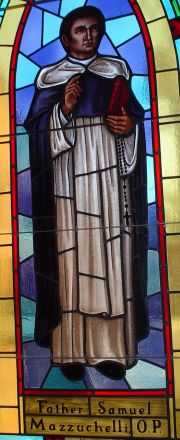Venerabilis: Perbedaan antara revisi
| Baris 4: | Baris 4: | ||
== Kekristenan == |
== Kekristenan == |
||
=== Katolik Roma === |
=== Katolik Roma === |
||
Dalam [[Ritus Latin]] [[Gereja Katolik]], seorang Katolik yang sudah meninggal bisa dinyatakan sebagai [[Pelayan Tuhan]] oleh seorang [[Uskup]] dan diusulkan untuk [[beatifikasi]] oleh [[Paus (Katolik Roma)|Paus]] melalui ''Congregatio de Causis Sanctorum''. |
Dalam [[Ritus Latin]] [[Gereja Katolik]], seorang Katolik yang sudah meninggal bisa dinyatakan sebagai [[Pelayan Tuhan]] oleh seorang [[Uskup]] dan diusulkan untuk [[beatifikasi]] oleh [[Paus (Katolik Roma)|Paus]] melalui ''Congregatio de Causis Sanctorum''. |
||
Apabila seorang yang "dianggap kudus" atau "dianggap martir" meninggal dunia, maka biasannya Uskup Diocesan memprakarsai proses penyelidikan. Salah satu unsusr penyelidikan. salah satu unsur penyelidikan apakah suatu permohonan khusus atau mukjizat telah terjadi melalui peranatara calon santa/santo ini |
|||
<!-- |
<!-- |
||
''The Venerable,'' is the style used for such a servant of God declared to be "[[Heroic virtue|heroic in virtue]]" during the investigation and process leading to possible [[canonization]] as a saint. Before a person is considered to be ''venerable,'' he or she must be declared as such by a proclamation, approved by the [[Pope]], of having lived a life that was "heroic in virtue" – the virtues being the [[Theological Virtues]] of faith, hope, and charity and the [[Cardinal Virtues]] of prudence, justice, fortitude, and temperance. The next step is [[beatification]], at which point the person is referred to as ''The Blessed'', and finally canonization, at which point the person is referred to as ''[[Saint]]''. Two modern and well-known examples of those who have been declared venerable are Popes [[Pius XII]] and [[John Paul II]], who were both declared venerable by [[Pope Benedict XVI]] in December 2009. |
''The Venerable,'' is the style used for such a servant of God declared to be "[[Heroic virtue|heroic in virtue]]" during the investigation and process leading to possible [[canonization]] as a saint. Before a person is considered to be ''venerable,'' he or she must be declared as such by a proclamation, approved by the [[Pope]], of having lived a life that was "heroic in virtue" – the virtues being the [[Theological Virtues]] of faith, hope, and charity and the [[Cardinal Virtues]] of prudence, justice, fortitude, and temperance. The next step is [[beatification]], at which point the person is referred to as ''The Blessed'', and finally canonization, at which point the person is referred to as ''[[Saint]]''. Two modern and well-known examples of those who have been declared venerable are Popes [[Pius XII]] and [[John Paul II]], who were both declared venerable by [[Pope Benedict XVI]] in December 2009. |
||
Revisi per 2 Agustus 2014 07.11

Venerabilis biasa digunakan sebagai julukan di beberapa gereja Kristen. Dalam bahasa Inggris venerable juga umum dipakai untuk penterjemahan beberapa julukan dalam agama Budha
Kekristenan
Katolik Roma
Dalam Ritus Latin Gereja Katolik, seorang Katolik yang sudah meninggal bisa dinyatakan sebagai Pelayan Tuhan oleh seorang Uskup dan diusulkan untuk beatifikasi oleh Paus melalui Congregatio de Causis Sanctorum.
Apabila seorang yang "dianggap kudus" atau "dianggap martir" meninggal dunia, maka biasannya Uskup Diocesan memprakarsai proses penyelidikan. Salah satu unsusr penyelidikan. salah satu unsur penyelidikan apakah suatu permohonan khusus atau mukjizat telah terjadi melalui peranatara calon santa/santo ini
| Tahapan Kanonisasi dalam Gereja Katolik |
|---|
| Pelayan Tuhan → Venerabilis → Beatifikasi → Santo/Santa |
Anglikanisme
Dalam Komuni Anglikan "Venerabilis" (disingkat sebagai "Ven") adalah julukan yang diberikan kepada wakil uskup (archdeacon) dalam gereja Anglikan
